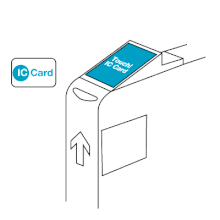You can help expand this article with text translated from the corresponding article in Japanese. (March 2024) Click [show] for important translation instructions.
|
Manaca, stylized in lowercase as manaca (マナカ, manaka) is a rechargeable contactless smart card used in Nagoya, Japan and the surrounding area in Aichi Prefecture. It launched on February 11, 2011, replacing the Tranpass magnetic fare card system. Since 2013, it has been part of Japan's Nationwide Mutual Usage Service, allowing it to be used in all major cities across the country.[2][3]
| Location | Usable nationwide Distributed in the Greater Nagoya Area |
|---|---|
| Launched | February 11, 2011 |
| Technology | |
| Manager | Transportation Bureau City of Nagoya and Meitetsu |
| Currency | Japanese yen (¥20,000 maximum load) |
| Stored-value | Pay as you go |
| Credit expiry | None[1] |
| Retailed |
|
| Website | www manaca |

Etymology
editThe name comes from the Japanese word mannaka (真ん中), meaning "center", because Nagoya is roughly in the center of Japan, and because it claims to be a central part of riders' lifestyles.[4] The card is administered by both the Nagoya City Transportation Bureau Development Organization and MIC (a subsidiary of Meitetsu); while MIC stylizes the name in romaji as "manaca", the City writes it in katakana.
Usage
editManaca has a feature set similar to other prepaid IC cards used across the country. It provides a convenient method of payment for train and bus fares while also being accepted as payment at some shops, restaurants, and vending machines.[5][6]
Manaca can be purchased from ticket machines located in city subway, city bus, and Meitetsu bus and train stations, and are available in both registered and unregistered form. Registered cards require the buyer to provide their name, date of birth, sex, and phone number, but can be replaced if lost or stolen. A registered card is also required in order to purchase a commuter pass. When a new or replacement card is issued, a 500 yen deposit is required, along with a minimum charge of an additional 500 yen. The deposit is refundable if the card is returned. Credit can be added to an existing card inserting it into a compatible credit terminal at any station, choosing the amount to add, and inserting bills or coins.[7]
Points
editThere are two kinds of point systems for Manaca: mileage points and Tamarun points. The point systems vary depending on the card's issuer, printed on the back of the card in the bottom left.
All cards accumulate mileage points whereas MIC cards can, when registered, also accumulate Meitetsu's Tamarun points.[8]
Mileage points are accumulated from spending money stored on Manaca as transportation fare, such as from riding the subway or non-JR trains. These points are calculated each month and are sent to the "point center" every month on the 10th, and are not automatically credited to the card. In order to use them as fare, riders must redeem them at station ticket machines, ticket windows, or fare-adjustment machines.[9] Despite interoperability with JR Central's TOICA, points cannot be used for JR train fare and are not accumulated by using JR services.[10]
Cards issued by MIC, once registered online, can also accumulate Tamarun points through purchases paid for with the card at participating vendors. Once acquired, Tamarun points can be used at these vendors to make purchases of goods. Unlike mileage points, these points cannot automatically be used as transportation fare.[8]
Points are also preserved when a registered card is replaced due to loss or theft.
Discounts
editWhen making the following transfers within 90 minutes using a single Manaca, an 80 yen discount is applied:[7]
- City bus ↔ City bus
- City bus ↔ Subway
- City bus ↔ Aonami line
- Subway ↔ Aonami line
- City bus ↔ Yutorito Line Raised Zone (Ozone - Obata Ryokuchi)
- Subway ↔ Yutorito Line Raised Zone (Ozone - Obata Ryokuchi)
Interoperation
editAs of March 23, 2013, Manaca began interoperability with nine other major Japanese IC cards as part of Japan's Nationwide Mutual Usage Service, allowing it to be used nationwide.[3] In Nagoya City, it can be used on the following transportation systems:[5][11][12]
- Nagoya Municipal Subway lines
- Meitetsu (Nagoya Railroad) lines
- Aonami Line
- Nagoya City Bus
- Meitetsu Bus
- Yutorito Line
- Linimo
It can also be used on other transportation systems across Aichi Prefecture, including the Aichi Loop Line (Aikan) and Toyohashi Railroad.
See also
editReferences
edit- ^ "利用方法について". Transportation Bureau City of Nagoya (in Japanese). Retrieved March 28, 2024.
- ^ Ito, Etsuro (October 2013). "Launch of Nationwide Interoperable Transport System IC Cards" (PDF). East Japan Railway Culture Foundation. Japan Railway & Transport Review. pp. 6–15. Retrieved March 7, 2024.
- ^ a b "Prepaid IC Cards in Japan". Retrieved May 15, 2013.
- ^ ICカード乗車券の名称とデザインを決定しました [Name and Design of Passenger's Smart Card has been Decided] (in Japanese). Nagoya Railroad. Retrieved December 3, 2010.
- ^ a b "ICカード「マナカ(manaca)」のサービス開始日について" [Concerning the Start of Manaca Smart Card Service] (in Japanese). Nagoya City Bureau of Transportation. Retrieved December 3, 2010.
- ^ "manaca(マナカ)とは" [Manaca] (in Japanese). E-Money Japan. Retrieved December 3, 2010.
- ^ a b "Manaca|English|名古屋市交通局". City of Nagoya Transportation Bureau. Retrieved May 15, 2013.
- ^ a b 名鉄たまルン (in Japanese). Retrieved April 23, 2012.
- ^ "manacaマイレージポイント" (in Japanese).
- ^ "TOICAとの相互利用" (in Japanese). Retrieved April 23, 2012.
- ^ "ICカード《manaca》の概要~当社の展開構想~" [Outline of This Company's Conception for Development of the Manaca Smart Card] (in Japanese). Nagoya Railroad. Retrieved December 3, 2010.
- ^ "manaca(マナカ)とTOICAの乗車券機能の相互利用サービスを平成24年4月21日(土)に開始します" (in Japanese). Nagoya Railroad. December 22, 2011. Retrieved April 23, 2012.
External links
edit- Nagoya City Transportation Bureau website (in Japanese)
- Nagoya City Transportation Bureau website (in English)
- Meitetsu website